The paper will outline what the Object Dialogue Boxes are, how they are used and offer explanation of why they work. It will explore how hedsor’s collaborative studio enquiry manifests itself as unfamiliar objects, and how this particular studio practice resonates by proxy in gallery or museum enquiries. To give a sense of the extent of the influence of this particular way of working this paper is co-written and evidenced by Joanne Davies, Senior Manager: Schools and Colleges for Manchester Art Gallery. Joanne contributes observational vignettes to show how enquiry-based learning uses the unexpected and unfamiliar to engage young people in creative interpretation. The material will consider the importance of modelling unfamiliar ways of learning and will reflect upon the benefits of persevering with more challenging learning experiences. The paper will consider the evidence of these creative enquiries in the light of how they might help develop social responsibility, communication, agency, self-reflection and self-esteem. Generally the perspectives and voices of artist and gallery have merged within this paper. Specific contributions from Manchester Art Gallery are indented as quotes.
hedsor’s practice straddles the worlds of learning and art practice, rationality and intuition, art interpretation and art history. The Object Dialogue Boxes (fig.1) are artworks that can be handled and used. The objects inside have dual functions – they meet aesthetic conventions as art objects while offering use as catalysts to facilitate, or stimulate, learning and interpretation. Two Examples of boxes other than the one under consideration here are Object Dialogue Box 4 at Museums Sheffield and Object Dialogue Box 8 at Turner Contemporary. The Boxes usually consist of approximately twenty unusual or unfamiliar art objects created around a theme or subject. The objects are made to work as interpretative devices with specific art collections and exhibitions, but are versatile and ambiguous enough in form to be used as teaching devices without their contexts.

Fig 1
The object dialogue boxes
The Boxes and associated processes have developed organically over a period of ten years out of a need to imaginatively engage learners in social and participatory enquiries in museums and galleries. The associated process include the preliminary artistic research in the setting in which they will be used, material-based enquiries in the studio and the educational processes involved in their use. They are also used in higher education to stimulate the dialogue and creative enquiry that is essential to contemporary creative practices. This organic expansion and development of practice runs parallel to a general gallery and museum culture-shift towards collaborative, co-constructive, dialogic, inter-disciplinary, enquiry-based learning. Each strand of these current educational terms form part of hedsor’s expectations of how the objects will be used and thought about. These learning strands are not additions to a sculptural practice – they are the practice as much as the physical form of the object is. In physical form hedsor objects build on an art historical lineage of object making that includes, ‘ready-mades’, Surrealist objects, Fluxus boxes and Neo-Geo objects.
The objects are formed from unexpected combinations of everyday objects. This usually happens when two or more everyday items that have a connection are merged. In the example below (fig.2) the umbrella draws thinking towards rain, water and protection from rain. The ping-pong balls suggest play, but at the same time they have the formal appearance of a molecule or a spherical unit. The applied rain related words force the readings of spherical units towards being drops of rain or molecules of water. The combined elements form something that is not easily knowable or nameable. To use a metaphor coined by Richard Wentworth the two objects become ‘emulsified … the elements bind but do not lose their distinct character.’1 There is a familiar recognition of elements and at the same time enough unfamiliarity to resist habitual responses.
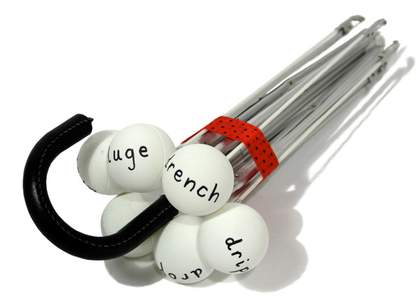
Fig 2
The gallery setting
In an art gallery setting these objects signpost openings and unexpected ways into artworks. The following paragraph gives an example of the range of creative inquiry that can be opened up by an unfamiliar object.
The umbrella allows people to connect with something familiar, and yet unfamiliar. It has no cover, no skin and no protection – it is functionally obsolete. To open it inside the gallery has elements of an absurd performance, superstition also tells us that it is unlucky to open an umbrella indoors. Opening it up might protect us from something different, something like rain: un-rain perhaps. Conversely, it might be an encouragement to get drenched. With prosaic thinking thwarted, questions surface – learners want to know more. Knowing smiles reveal awareness that something is ‘at play’. Why, what about, when, does it, how? The un-brella is humorous, a metaphor for rainy Manchester as well. The drip, drop, drench nature of the north, the sound of the ping-pong balls rattling against the metal frame as it is opened or moved. Singing in the rain – open minds are flooded with new ideas. Semi-closed and inverted the umbrella shrugs off any certain or fixed thinking, the changing thing changes. New thoughts emerge – spider, insect, something mechanical (fig.3). The object appropriates different space through activation – the space of the sky between ‘brolly’ and clouds and the space underneath a spider – neither ‘correct’, both possible.
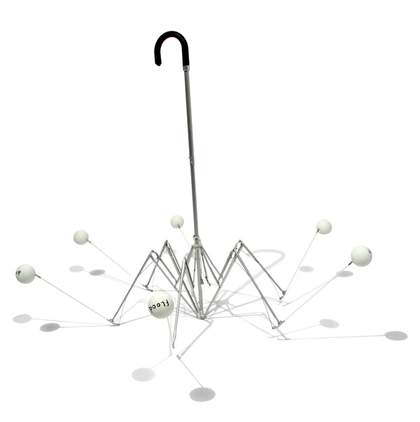
Fig 3
The key point here is that in the struggle to know and name the object the learner must mentally negotiate its difference. Addressing the questions that the objects pose has the effect of opening the learner up to change. Imaginative thinking is required and expected in the process introducing a kind of flux into the learning. This open-minded enquiry originates in the enquiries of the studio. Here, objects are subjected to imaginative play and a thinking-through-making process, they are deconstructed a little until nomenclature becomes less certain. Combinations of such objects retain clearly identifiable fragments of materiality that recall their place in the world, but the full familiarity is broken. In this way doubt and uncertainty finds form in the objects and in use provokes a questioning approach in the gallery or museum.
Tolerating not knowing
At the core of practice artists must be able to defamiliarise themselves from the everyday in order to see afresh. They must be able to tolerate ‘not knowing’ where an enquiry might be going in order to see something new. This is not a mindless process; it is a switch to, and an immersion in, a different way of thinking. This re-visioning of reality enables the overlooked to be reconsidered and new understandings to emerge. According to Victor Shklovsky the change in perception brought about by defamiliarisation is how art begins. He states: ‘After we see an object several times, we begin to recognise it. The object is in front of us and we know about it, but we do not see it – hence, we cannot say anything significant about it. Art removes objects from the automatism of perception’2
Defamiliarisation is also an ingredient in successfully engaging with art. The intention behind the creation of the Box’s objects is that they resist ‘automatic perception’. Learners, in their defamiliarising encounter with these objects, have the possibility of seeing their environment with renewed vision.
To make the objects everyday items are laid out in physical space and a process of defamiliarisation begins. To use cooking as a metaphor, objects, associated images, materials and words are put together in a big pan of water and left to ‘simmer’. The ‘simmering’ is in the collective mind and actions of hedsor; thought happens through materials with unexpected combinations expected. Objects are played with, put next to, broken, combined with words, combined with images, stacked, sliced, photographed, used. It is a deliberate ‘making strange’, a courting of the unexpected and unfamiliar, with an aim of making objects that are a mental asset to enquiry.
Objects become mental assets to interpretation when the visual and metaphorical language is deliberately tuned to a subject or context. The ‘tuning’ of these objects to collections happens when the artist’s enquiry begins in the gallery or museum. Changes in learning start with the gallery staff – they are asked to use their experience of their galleries to produce a list of thematic words that echo, or evoke, issues that they feel are present within the collection. These are often personal connections rather than factual or instutional ones. The words below (fig.4) were formed as an initial enquiry by the staff at Manchester Art Gallery.
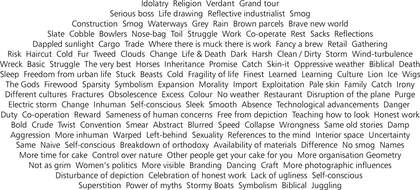
Fig 4
Reducing the Importance of Specific Knowledge and Material Fact
Through this proto-enquiry, the material facts of the objects referred to and the specific knowledge about them reduce in importance. Their points of reference have been weakened to the point of doubt. The words relate to things and concepts within the gallery or museum, but are shaken free from any direct nomenclature. For example, from the words above, the contributors will know that the word ‘dancing’ was generated by an aspect of their collection (a painting or an object). A small degree of defamiliarisation occurs and a space for different thinking is established. The term is defamiliarised and generic enough to become an orientation point for thinking about ‘dancing’ in general. In the studio hedsor constellate or cluster together these words with associated images, objects, texts, opinions and anecdotes. The aim of this constellating process is to find and establish non-literal gateways, orientation points, or nodal points into the issues and subjects within the collection. In the studio-enquiry and making stages mentioned above, everyday items are found that have lateral rather than literal connections to the words. Simply put, ballet shoes would literally be related to ‘dance’, but an old gramophone record, or a piece of parquet flooring could more obliquely refer to ‘dance’. The ballet shoes, gramophone record and parquet flooring combined together, or reconfigured, might retain a visual language of dance but might refer to several other realms of thought because of the doubt that becomes inherent in the combined materiality. This process of defamilairisation and recombination is a way of ensuring that any enquiries stimulated by the objects would have a high probability of relevance.
Any painting, sculpture, historical exhibit etc. will have narratives and or themes that are generated by the visual language, symbols, signs etc. Universal themes like ‘death’ can be overt narratives or covert narratives within many artworks in a collection. By making an object that also has a narrative of death (however incomplete) the learner who decides to use it will offer a point of intersection (a nodal point) that will tend to be activated if a person in an open-ended enquiry is interested in exploring this. In this sense there is no ‘truly’ open-ended enquiry. An imaginative learning process could be thought of as limitless but there are always ideologies present – in the learner, in the facilitator, in the artwork. Involving the staff in this process does not encourage them to dictate or manipulate interpretations. In taking part in the identification of themes that are present staff contribute personal words that that they personally relate to themes and that they perceive to be present as direct stimuli originating from the paintings, sculptures, craft objects etc.. When the objects are used in learning nobody is ever given an object, or directed towards a specific work – the learner selects an object and self-navigates, responding to the visual world around them. The object becomes a compass for this navigation.
Creating the setting
To enable this way of thinking to become an active factor in the learning setting a corresponding openness needs to develop in the thinking of the workshop facilitators. This was already happening when the Box was introduced and has flourished into a dynamic learning project:
The Object Dialogue Box was originally commissioned by Manchester Art Gallery’s Interpretation Team (since devolved) as part of an initiative to consider new ways of looking at the visible and stored collections. The original idea was to redevelop aspects of the permanent collection displays in ways that built upon existing achievements. There was a desire to extend the participatory and dialogic relationship that had been already established. By introducing the Object Dialogue Box as an element of interpretative practice it was hoped that a wide range of gallery users and staff would be enabled to develop imaginative, creative and personal responses to the material within the collections. In many ways an institutional enquiry was conducted into how imagination can increase understanding and knowledge about collections and objects. By allowing staff and visitors to physically hold objects the importance of sensory and physical experience in learning was brought into sharper focus. This enquiry was intended to examine the connections and distinctions between personal and curatorial knowledge and ultimately to influence approaches to display and interpretation.3
As a result of this open thinking the Object Dialogue Box has been successfully used by Manchester Art Gallery at both primary and secondary levels of education. There is obviously a qualitative difference between the approaches taken for each level, primary uses the objects to assist with story writing, as inspiration for character development and scene setting. Imagination is still a fundamental aspect of the learning process at secondary level but crucially there is much more emphasis given to grounding it with critical thought. Within this paper there is only enough scope to consider secondary approaches.
The gallery’s secondary level approach has been in the form of a workshop entitled ‘Thinking Visually’, a session which explores a critical and contextual approach to engaging with artworks. Working individually and collaboratively, students use the objects from the box to create dialogue, discover meanings and form their own interpretations of images and artefacts in the gallery. 4
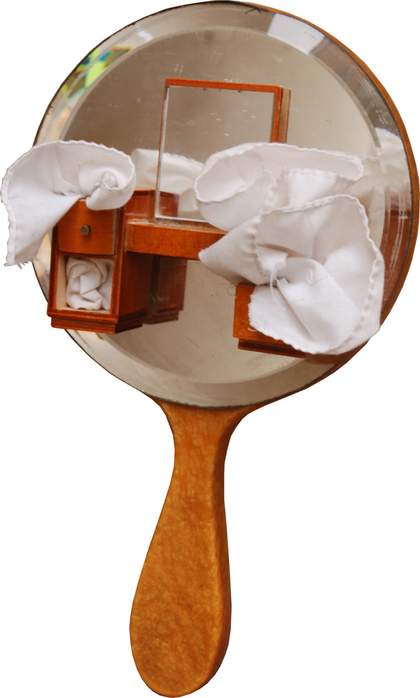
Fig 5
As discussed throughout this paper hedsor’s objects present unfamiliar challenges to the learner, the process of open enquiry can also be unfamiliar to learners. So that the young people are not overwhelmed it is important that some kind of example is modelled for them. Students are given a demonstration by the gallery educator of how they could use one of the objects to explore the twentieth century and contemporary art collections. The ‘dressing table/vanity mirror’ (fig.5) is often paired with Michael Craig-Martin’s ‘Inhale’ for this purpose. It is stressed to the students that there was never any intention that this object would be related to this particular painting and none of the hedsor objects had prescribed links to artworks. Young people are asked to consider why a particular hedsor object was chosen to connect with this painting. They are encouraged to physically explore the object first, to investigate its qualities and to use some of the emerging ideas to apply to other objects.
With more confident young people thoughts and feelings can be offered which instantly ignite enquiry and discussion amongst their peers. Where more guidance is needed, the gallery educator models a limited enquiry into the formal aspects of the work by asking questions about the colours, materials and artistic processes used. With a reasonable degree of direction, the gallery educator indicates that in the painting the artist plays around with scale, colour, perception of object and composition. In the case of Inhale the differing sizes and scales of the objects depicted make their objecthood unfamiliar, unexpected and strange. The painting has two obvious connections with the ‘dressing table/vanity mirror’: the play on scale and the degree of unfamiliarity in the combination of elements. The example is simple enough to indicate what is expected, there is trust in their ability to go much further than this. In groups of four or five they are invited to select an object and consider how it makes them feel and think.
The following observation is of a group of four year eleven students who use a ‘drum’ (fig.7) from the Object Dialogue Box to unexpectedly navigate their way to Derek Jarman’s painting ‘Queer’ 1992.

Fig 7
The students selected the drum and discussed its qualities. They talked about the drum’s inverted skin (it is an embroidery of two birds that has been fastened wrong-side-out as the skin of the drum). Their attention focused upon the layers unseen; the love birds, their togetherness, a bonded and contained image, a word inscribed in reverse, the ability to still beat the drum.
With these thoughts in mind they wandered through the galleries and came upon Jarman’s piece. At first the colour, the bold use of red and the gigantic love heart captivated them. One of them said, ‘It’s like the two birds on the drum, contained and held within the canvas.’ They read the descriptive label a little more and noticed the words scratched into the surface: ‘Queer’. They discussed this word and considered the action of the artist – what was he telling us? The painting that was at first beautiful and warming to them had now become damaged, torn, exposed – the artist was making a statement.
These words came to life when the students led a larger group discussion around the painting. They started a recounting of their enquiry to this larger group with the slow beat of the ‘drum’. They explained that the ‘drum’ was the painting’s heartbeat; they wanted the others to see its blood red appearance pulsing as they heard each beat. The students thought that the reality of the painting was that the beat was no longer heard as the artist had since died. This painting was both a memorial to Jarman and statement of his death due to AIDS in the 1990s. He had wanted to love and be loved, but his choices had been difficult for some to bear. The drumbeat began to slow down until the heartbeat stopped. The students showed the ‘drum’, with the hidden lovebirds, a secret love that maybe the artist didn’t want to share. They had understood Jarman’s political protest and his bold expression of sexuality.5
This observation shows how important it is to allow enough time for learners to familiarise themselves with the unexpected and unfamiliar. It also shows the benefit of the hedsor’s initial enquiry into the thematic strands of the collection. The embroidery was found at a car boot sale and was used because the reverse side looked like an expressionistic painting. hedsor were aware that the ‘love-birds’ depicted by the stitching was obviously symbolic of love, the presentation of the reverse side of the embroidery gave learners a more tangled and complicated view. Loose ends were left untied, the association of beats and rhythms, the noises made by birds. The form of the drum also looked like an embroidery ring evoking solitary and collective craft projects. The propensity for the students’ connections were latent in the object in that the visual language of the object acts as a point of intersection between issues around, love, ornithology, craft, loneliness, togetherness, rhythm and marching. Unprompted and undirected, the students enquiry became manifest through an enquiry that focused upon the relationship between the objects and the artwork and the themes and subjects that were constellated by this relationship. The specific connection the students made to the Jarman piece, the physical use of the object as an interpretative experience, and their emotional involvement in the piece has both depth and resonance to them and the wider group that the performative experience is shared with.
The benefit offered to young people who use the box is through supporting proportionally more ownership of their learning than they might have in a school environment. Imagination, creative thinking, speculative ideas, doubts, questions and playful thinking all find form that is valued. Trust is given to the learning groups that they will take responsibility for working out what matters to them and co-construct something. The co-construction develops out of the object and gains momentum with an evidenced link: ‘It’s like the two birds on the drum, contained and held within the canvas.’ In this case the group went on to build a dialogue around sexuality. Making a conjecture from the evidence collected that at the core of the link is ‘love’ – heterosexual and homosexual love. By not reading more than the title initially, the group of year eleven students were left to decipher the ambiguous intention behind the scratched word ‘Queer’. It could be seen as the language of protest, an affirmation of pride; but it could also be interpreted as homophobic without the contextual information.
With their emerging sexualities it is easy to see why a group of teenagers might locate their enquiry around an artwork like Queer. Artworks such as this can act as examples of agency, where artistic endeavour provides a way of trying to alter the world that does not fit one’s experience or perspective. The work also acts as an anchor for the wider group to discuss, argue and modify their opinions about sexuality. Because young people are in an emergent state and are in the process of shaping their opinions about the world, it is especially important to identify legitimate ways for them to communicate what is important or needed, and to see ways to bring about necessary change.
As the young people established the facts about Queer by reading the interpretative text, their enquiry became attached to a body of knowledge. In this case they recognised that the art object represents an embodiment of a wider campaign by Jarman to be accepted for who he was. By beating the drum in the re-presentation of their enquiry to the wider group the students go well beyond engaging with a body of knowledge. They evoke a beating heart, a protest march, or even some kind of ritual for the summoning of the dead. The painting seems to be brought to life by a spontaneously devised experience. The creative interventions they make are so appropriate to the enquiry and the artwork they extend and amplify the painting’s possibilities.
In contrast to the enquiry into Jarman’s Queer the following observation is an example of how an object from the box worked with a more traditional artwork. Three year nine students, selected a ‘spoon’ (fig.9) and made a link to a painting by John Roddam Spencer Stanhope, titled The Waters of Lethe by the Plains of Elysium c.1880 (fig.10).

Fig 9
The students discussed the qualities of the spoon. First, they talked about its inability to be a spoon as it no longer fits in a mouth, its general weight, the contrast of the decorative handle and the bandaged spoon bowl, the comforting quality of holding the bandaged (plasticine) ball in hand. They also discussed the weight of the bowl and how it doesn’t allow one to hold it like a spoon and the use of bandage to hold, wrap and contain something unknown (plasticine) inside.
With these thoughts in mind the girls wandered through the historical galleries and focused on The Waters of Lethe by the Plains of Elysium. Through the spoon the girls led a discussion that began with a description of the painting. They named it as a mythical painting with people dressed in classical clothing, a setting in the past, of people entering waters to heal themselves and begin again. They drew attention to the sense of hope in the background of the painting as people are moving on, dancing and enjoying life again. The girls explained how they connected the spoon with the painting; they connected the layers of the bandage with the layers of clothing on the depicted people. They speculated that the people in the painting are unwrapping their layers to reveal hidden sicknesses. They saw the people shedding their clothes and entering the water to heal themselves.
Reading the label brought all these enquiries towards a body of knowledge. The girls had learnt that ‘Lethe’ literally means forgetfulness, concealment or oblivion, relating to the Greek word for ‘truth’. They had learnt that the dead drank the waters of Lethe to forget their past, their time on earth, and that when their memories are erased they are reincarnated. The girls formed a particularly strong relationship between the spoon and the painting. They felt that the concealed bowl wrapped in bandage was Lethe. The forgotten was now wrapped in the bandage, never to be lived again. The spoon gave the ability to start again and drink away the past.6
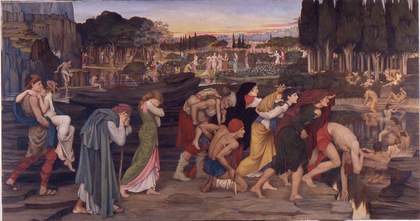
John Roddam Spencer Stanhope The Waters of Lethe by the Plains of Elysium c.1880 Tempera on canvas. Fig 10
As an additional stimuli to their enquiry the girls selected phrases from a prompt box that hedsor call a first aid kit, which are included in some Object Dialogue Boxes. They take differing forms, but are created to expand, help and guide learners. In this case the first aid kit is a collection of idiomatic phrases that echo some of the themes of Manchester Art Gallery’s collections. These words and phrases can be used to aid and enhance interpretation. The girls picked out the following phrases in connection with the painting:
‘Spoon fed’
They communicated that they had not been given the easy option by the facilitator of the session. Rather than being ‘spoon fed’ they were having to find alternative ways of looking at works.
‘A spoonful of sugar helps the medicine go down’
The girls talked about the idea of reincarnation; that the Lethe would set us free. They reflected that with death comes something else: another life and a chance to start again.7
This example shows the process of familiarisation, the process of nomenclature and the process of evaluation through touch and close proximity. The selection of this particular painting poses some questions about the assumptions we might make about what appeals to young people and why. We read of the girls relating an object to an image without knowing exactly why, the girls had opened up the space of enquiry. The object is ambiguous in its form and is capable of taking on the projections of those who use it. The connections between the thinking and the painting are not made by design. In their examination of the explanatory text that accompanied the painting the girls were able to take an open and creative enquiry towards a body of knowledge. They had ownership over their learning and extracted what was relevant. This kind of motivated learner is usually inclined to ask for more factual information on the basis of the questions the experience has raised. Each member of the group is likely to have different questions to each other. Their questions are all at once related, personally relevant and divergent.
The two examples given present a harmonious account of learning with an Object Dialogue Box. However, making challenges and questioning differing perspectives are vital and fundamental to creative learning and dialogue. Joanne Davies reflects:
With these approaches students learn from each other, they form open conversations and negotiate differing opinions, which they can build upon and add to. They are encouraged to talk and work collaboratively. This collective approach means they work together, learn through the experience and are challenged. Teachers and tutors, who observe these kinds of sessions, are surprised as students that are usually quiet, begin to speak out, take the lead and contribute to discussions. This unfamiliar experience helps them feel comfortable with the risk of saying something new or unexpected. The discussions help students to gain confidence and develop a voice, they are able to play with new concepts and ideas.8
The important issue is that the students want to discuss something because it is meaningful and relevant to them. Even though they can struggle with the presence of uncertainty they also seem to relish ‘not being given the easy option’. Conversely, the struggle with the objects and artworks improves their confidence with the subject.
This paper has looked at hedsor’s practice, given an idea of how unfamiliar objects come into being and indicated how they are used in enquiry-based learning in Manchester Art Gallery. This kind of creative learning allows us to see with renewed vision and when this process is adapted and ‘tuned’ appropriately to gallery learning it can enable an approach to bodies of knowledge without compromising creativity. The objects within an Object Dialogue Box in their provocations offer gateways and openings to this type of learning; they are symbols of the unfamiliar and unexpected.
The examples demonstrate how the enquiry relationship between the objects and the artworks stimulate discussion, extend vocabulary, set a learning challenge and encourage the development of imaginative link-making. Young people learn the importance of tolerating ‘not knowing’ exactly where an enquiry might be leading; they learn to live with uncertainty in learning. Through art, young people learn to consider the opinions of others; they discover visual language, metaphor, symbols and encounter facts within appropriate contexts. They talk to each other, they learn in groups, they have different opinions and they contribute. Enquiry means that they have ownership of their learning; they can talk about what is relevant to them in a non-prescriptive way, but with focus. They learn that proximity, touch and other sensory approaches are important experiences in learning. They are involved in an authentic experience that they can alter and have influence upon, on a moment-to-moment basis. They construct learning together, have agency and learn to trust in the importance of their ‘voice’. Through hedsor’s objects, art and enquiry-based learning they embrace the unfamiliar and unexpected – they think, talk, question, struggle, grow, research, experience and change.
Joanne Davies is Senior Manager: Schools and Colleges at Manchester Art Gallery.
Kimberley Foster and Karl Foster form the artistic partnership hedsor. They both lecture at Norwich University of the Arts.
This paper is part of a series that are from or in response to presentations made at the Worlds Together Conference at Tate, 2012.
